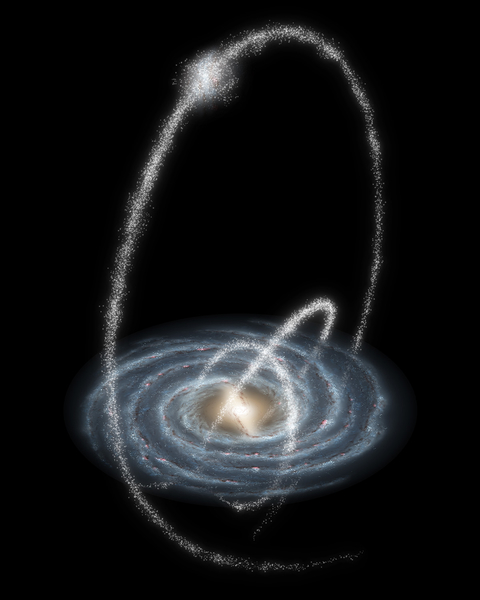Especially the One You're In?
University of Arizona | 2018 Jun 06
Pinning down the mass of a galaxy may seem like an esoteric undertaking, but scientists think it holds the key to unraveling the nature of the elusive, yet-to-be-seen dark matter, and the fabric of our cosmos.
- An artist's interpretation of what happens as a satellite merges with its host galaxy: These streams of stars arcing high over the Milky Way are remnants of galaxies and star clusters, mangled and torn apart by our galaxy's gravitational stresses over billions of years. Extending over much of the northern sky, the streams lie between 13,000 and 130,000 light-years from Earth. (Credit: NASA/JPL-Caltech/R. Hurt/SSC/Caltech)
A new technique for estimating the mass of galaxies promises more reliable results, especially when applied to large datasets generated by current and future surveys, according to a research team led by Ekta Patel at the University of Arizona. Published in the Astrophysical Journal, the study is the first to combine the observed full three-dimensional motions of several of the Milky Way's satellite galaxies with extensive computer simulations to obtain a high-accuracy estimate for the mass of our home galaxy.
Determining the mass of galaxies plays a crucial part in unraveling fundamental mysteries about the architecture of the universe. According to current cosmological models, a galaxy's visible matter, such as stars, gas and dust, accounts for a mere 15 percent of its mass. The remaining 85 percent is believed to reside in dark matter, a mysterious component that never has been observed and whose physical properties remain largely unknown. The vast majority of a galaxy's mass (mostly dark matter) is located in its halo, a vast, surrounding region containing few, if any, stars and whose shape is largely unknown.
In a widely accepted cosmological model, dark-matter filaments span the entire universe, drawing luminous ("regular") matter with them. Where they intersect, gas and dust accumulate and coalesce into galaxies. Over billions of years, small galaxies merge to form into larger ones, and as those grow in size and their gravitational pull reaches farther and farther into space, they attract a zoo of other small galaxies, which then become satellite galaxies. Their orbits are determined by their host galaxy, much like the sun's gravitational pull directs the movement of planets and bodies in the solar system. ...
Estimating the Mass of the Milky Way Using the Ensemble of Classical Satellite Galaxies - Ekta Patel et al
- Astrophysical Journal 857(2):78 (2018 Apr 20) DOI: 10.3847/1538-4357/aab78f
arXiv.org > astro-ph > arXiv:1803.01878 > 05 Mar 2018
